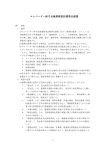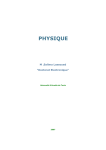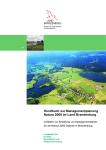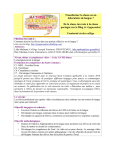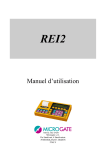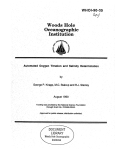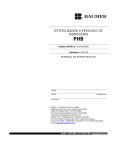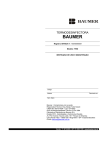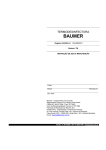Download Desalination Economic Evaluation Program
Transcript
CO MPU T ER M A N UAL S E RI E S No . 1 9 Desalination Economic Evaluation Program (DEEP-3.0) User’s Manual COMPUTER MANUAL SERIES No. 19 Desalination Economic Evaluation Program (DEEP-3.0) User’s Manual INTERNATIONAL ATOMIC ENERGY AGENCY, VIENNA, 2006 The originating Section of this publication in the IAEA was: Nuclear Power Technology Development Section International Atomic Energy Agency Wagramer Strasse 5 P.O. Box 100 A-1400 Vienna, Austria DESALINATION ECONOMIC EVALUATION PROGRAM (DEEP-3.0) IAEA, VIENNA, 2006 IAEA-CMS-19 © IAEA, 2006 Printed by the IAEA in Austria April 2006 FOREWORD DEEP is a Desalination Economic Evaluation Program developed by the International Atomic Energy Agency (IAEA) and made freely available for download, under a license agreement (www.iaea.org/nucleardesalination). The program is based on linked Microsoft Excel spreadsheets and can be useful for evaluating desalination strategies by calculating estimates of technical performance and costs for various alternative energy and desalination technology configurations. Desalination technology options modeled, include multi-stage flashing (MSF), multi-effect distillation (MED), reverse osmosis (RO) and hybrid options (RO-MSF, RO-MED) while energy source options include nuclear, fossil, renewables and grid electricity (stand-alone RO) . Version 3 of DEEP (DEEP 3.0) features important changes from previous versions, including upgrades in thermal and membrane performance and costing models, the coupling configuration matrix and the user interface. Changes in the thermal performance model include a revision of the gain output ratio (GOR) calculation and its generalization to include thermal vapour compression effects. Since energy costs continue to represent an important fraction of seawater desalination costs, the lost shaft work model has been generalized to properly account for both backpressure and extraction systems. For RO systems, changes include improved modeling of system recovery, feed pressure and permeate salinity, taking into account temperature, feed salinity and fouling correction factors. The upgrade to the coupling technology configuration matrix includes a recategorization of the energy sources to follow turbine design (steam vs. gas) and cogeneration features (dual-purpose vs. heat-only). In addition, cost data has also been updated to reflect current practice and the user interface has been refurbished and made user-friendlier. The IAEA officers responsible for this publication were M. Methnani and B. Misra of the Division of Nuclear Power. EDITORIAL NOTE The use of particular designations of countries or territories does not imply any judgement by the publisher, the IAEA, as to the legal status of such countries or territories, of their authorities and institutions or of the delimitation of their boundaries. The mention of names of specific companies or products (whether or not indicated as registered) does not imply any intention to infringe proprietary rights, nor should it be construed as an endorsement or recommendation on the part of the IAEA. CONTENTS 1. INTRODUCTION....................................................................................................................... 1 2. DESALINATION PROCESSES ................................................................................................ 1 2.1. Multi stage flash (MSF) distillation...................................................................................... 2 2.2. Multiple effect distillation (MED)........................................................................................ 3 2.3. MED plants with vapour compression (VC) ........................................................................ 4 2.4. Reverse osmosis (RO) .......................................................................................................... 4 3. DEEP-3.0 PROGRAM CHANGES ............................................................................................ 4 4. DEEP-3.0 MODEL DESCRIPTION........................................................................................... 5 4.1. Thermal performance model................................................................................................. 6 4.2. RO performance model......................................................................................................... 8 4.3. Hybrid performance model................................................................................................... 9 4.4. Cost model............................................................................................................................ 9 5. DEEP-3.0 PROGRAM INSTRUCTIONS ................................................................................ 10 5.1. Installing DEEP .................................................................................................................. 10 5.2. Running a DEEP case......................................................................................................... 10 5.3. Case input form .................................................................................................................. 11 6. DEEP-3.0 INPUT OUTPUT DESCRIPTION .......................................................................... 14 6.1. Input sheet........................................................................................................................... 14 6.2. Output sheet........................................................................................................................ 18 7. DEEP-3.0 SAMPLE CASES .................................................................................................... 19 REFERENCES.................................................................................................................................. 23 CONTRIBUTORS TO DRAFTING AND REVIEW....................................................................... 25 1. INTRODUCTION Desalination is known to be an energy intensive process, requiring mainly low-temperature steam for distillation and high-pressure pumping power for membrane systems. Traditionally, fossil fuels such as oil and gas have been the major energy sources. However, fuel price hikes and volatility as well as concerns about long-term supplies and environmental release is prompting consideration of alternative energy sources for sewater desalination, such as nuclear desalination [1] and the use of renewable energy sources[2]. If we add to this the fact that the coupling methods between power and desalination units can also vary, the need for a performance and cost analysis tool to assist in design selection and optimization becomes clear. The Desalination Economic Evaluation Program (DEEP) is a spreadsheet tool originally developed for the IAEA by General Atomics[3] and later expanded in scope by the IAEA, in what came to be known as the DEEP-2 version [4]. Recently, the models have been thoroughly reviewed and upgraded and a new version, DEEP-3.0, has been released[5]. The program allows designers and decision makers to compare performance and cost estimates of various desalination and power configurations. Desalination options modeled include MSF, MED, RO and hybrid systems while power options include nuclear, fossil and renewable sources. Both co-generation of electricity and water as well as water-only plants can be modeled. The program also enables a side-by-side comparison of a number of design alternatives, which helps identify the lowest cost options for water and power production at a specific location. Data needed include the desired configuration, power and water capacities as well as values for the various basic performance and costing data. 2. DESALINATION PROCESSES Desalination systems fall into two main design categories, namely thermal and membrane types [6]. Thermal designs including multi-stage flash (MSF) and Multi-effect distillation (MED), use flashing and evaporation to produce potable water while membrane designs use the method of Reverse Osmosis (RO), shown in Fig. 1. With continuing improvements in membrane performance, RO technology is increasingly gaining markets in seawater desalination and hybrid configurations, combining RO with MED or RO with MSF have also been considered (Fig. 2.). Fig. 1. Sketch of RO layout. 1 Fig. 2. Sketch of hybrid MED-RO layout. 2.1. Multi stage flash (MSF) distillation Figure 2 shows the schematic flow diagram of an MSF system. Seawater feed passes through tubes in each evaporation stage where it is progressively heated. Final seawater heating occurs in the brine heater by the heat source. Subsequently, the heated brine flows through nozzles into the first stage, which is maintained at a pressure slightly lower than the saturation pressure of the incoming stream. As a result, a small fraction of the brine flashes forming pure steam. The heat to flash the vapour comes from cooling of the remaining brine flow, which lowers the brine temperature. Subsequently, the produced vapour passes through a mesh demister in the upper chamber of the evaporation stage where it condenses on the outside of the condensing brine tubes and is collected in a distillate tray. The heat transferred by the condensation warms the incoming seawater feed as it passes through that stage. The remaining brine passes successively through all the stages at progressively lower pressures, where the process is repeated. The hot distillate flows as well from stage to stage and cools itself by flashing a portion into steam which is re-condensed on the outside of the tube bundles. MSF plants need pre-treatment of the seawater to avoid scaling by adding acid or advanced scale-inhibiting chemicals. If low cost materials are used for construction of the evaporators, a separate deaerator is to be installed. The vent gases from the deaeration together with any non-condensable gases released during the flashing process are removed by steam-jet ejectors and discharged to the atmosphere. 2 2 Fig. 3. Sketch of MSF layout. 2.2. Multiple effect distillation (MED) Figure 3 shows the schematic flow diagram of MED process using horizontal tube evaporators. In each effect, heat is transferred from the condensing water vapour on one side of the tube bundles to the evaporating brine on the other side of the tubes. This process is repeated successively in each of the effects at progressively lower pressure and temperature, driven by the water vapour from the preceding effect. In the last effect at the lowest pressure and temperature the water vapour condenses in the heat rejection heat exchanger, which is cooled by incoming seawater. The condensed distillate is collected from each effect. Some of the heat in the distillate may be recovered by flash evaporation to a lower pressure. As a heat source, low pressure saturated steam is used, which is supplied by steam boilers or dual-purpose plants (co-generation of electricity and steam). Fig. 4. Sketch of MED layout. Currently, MED processes with the highest technical and economic potential are the low temperature horizontal tube multi-effect process (LT-HTME) and the vertical tube evaporation process (VTE). In LT-HTME plants, evaporation tubes are arranged horizontally and evaporation occurs by spraying the brine over the outside of the horizontal tubes creating a thin film from which steam evaporates. In VTE plants, evaporation takes place inside vertical tubes. 3 2.3. MED plants with vapour compression (VC) In some MED designs, a part of the vapour produced in the last effect is compressed to a higher temperature level so that the energy efficiency of the MED plant can be improved (vapour compression). To compress the vapour, either mechanical or thermal compressors are used. 2.4. Reverse osmosis (RO) Reverse osmosis is a membrane separation process in which pure water is “forced” out of a concentrated saline solution by flowing through a membrane at a high static transmembrane pressure difference. This pressure difference must be higher than the osmotic pressure between the solution and the pure water. The saline feed is pumped into a closed vessel where it is pressurised against the membrane. As a portion of the water passes through the membrane, the salt content in the remaining brine increases. At the same time, a portion of this brine is discharged without passing through the membrane. RO membranes are made in a variety of modular configurations. Two of the commercially successful configurations are spiral-wound modules and hollow fibre modules. The membrane performance of RO modules such as salt rejection, permeate product flow and membrane compaction resistance were improved tremendously in the last years. The DEEP performance models cover both the effect of seawater salinity and the effect of seawater temperature on recovery ratio and required feedwater pressure. A key criterion for the RO layout is the specific electricity consumption, which should be as low as possible. That means, the recovery ratio has to be kept as high as possible and the accompanying feedwater pressure as low as possible fulfilling the drinking water standards as well as the design guidelines of the manufactures. Since the overall recovery ratios of current seawater RO plants are only 30 to 50%, and since the pressure of the discharge brine is only slightly less than the feed stream pressure, all large-scale seawater RO plants as well as many smaller plants are equipped with energy recovery turbines. 3. DEEP-3.0 PROGRAM CHANGES Version three features important changes from previous versions, including upgrades in thermal and membrane performance and costing models, the coupling configuration matrix and the user interface, as well as a thorough review of the configuration templates. • The thermal model upgrade includes: 1. A generalization of the lost shaft work to model both extraction and backpressure coupling configurations. 2. Improvements in the distillation thermal balance model and Gain Output Ratio (GOR) calculation. 3. Adding a new Thermal Vapor Compression (TVC) option. 4 4 • The RO model, upgrade includes: 1. New and validated correlations for feed pressure and permeate salinity, accounting for the effects of feed salinity, temperature and fouling. 2. A new correlation for recovery ratio estimates. • The coupling configuration upgrade includes a re-categorization of the energy sources to follow current practice. The coupling scheme selection follows turbine design (steam vs. gas) and co-generation features (dual-purpose vs. heat-only). The energy source categorization includes nuclear, fossil and renewable options, with the latter being a new addition. 4. DEEP-3.0 MODEL DESCRIPTION A flow chart for the overall programme layout is shown in Fig. 5. Input Forms/Sheets Performance Analysis Thermal/RO Cost Anlaysis Thermal/RO Output Sheets Fig. 5. General DEEP program layout. This section gives a brief overview of the models, including the thermal and RO performance models as well as the costing model. 5 4.1. Thermal performance model The flow chart for this model is shown in Fig. 6. GOR Calculation Flow/Pumping Power Calculations Lost Shaft Work Fig. 6. Flowchart for thermal performance model. GOR Model In the DEEP-3.0 model, the user has the choice of specifying the GOR as a design parameter or letting the program calculate an estimate. For MSF systems, the GOR is calculated as follows: GOR = λh / ch / (dTbh +dTbpe)* ( 1 - exp( -cvm * dTao / λm ) (1) And for MED systems, the GOR is calculated as follows: GOR = λh / (λm * dTae / dTdo + ch * ( dTph + dTbpe ) ) (2) Where λh λm Tmb Tsw DTdls ch cvm dTao dTae dTbh dtbpe dTph = = = = = latent heat of heating vapour, kJ/kg average latent heat of water vapour in MSF stages, kJ/kg maximum brine temperature, °C seawater temperature, °C brine to seawater temperature difference in last stage, °C specific heat capacity of feedwater in brine heater, kJ/kg/K average specific heat capacity of brine in MSF plant, kJ/kg/K overall working temperature range, °C average temperature drop per effect, °C brine heater feed temperature gain for MSF, °C boiling point elevation, °C Preheating feed temperature gain, °C For the case of thermal vapor compression units coupled to MED or MSF systems, the GOR model is generalized as follows: GORtvc = GOR(1+Rtvc) 6 (3) Where Rtvc is defined as the ratio of entrained vapour flow to motive steam flow, an input design parameter. The top brine temperature Tmb is also retained as a design parameter and as such, can be input by the user or alternatively, calculated given an input steam temperature. Given as input the salt concentration factor CF, the cooling seawater temperature gain ΔTc and the product water flow rateWp, estimates for reject brine flow Wb , make-up feed flow Wf and condenser cooling water flow Wc, could also be calculated as follows, Wb = Wp / (CF-1) Wf = CF.Wb Wc= Qc / (ccΔTc) (4) (5) (6) Where Qc refers to the net condenser heat load and cc refers to the specific heat capacity of cooling water. While specific heat transfer areas could also be calculated in DEEP in a straightforward manner, the current approach, where user input is expected for specific capital costs ($/m3/d), is considered adequate for the purposes of DEEP and is therefore retained. Lost Shaft Work Model In DEEP-3.0, the lost shaft work is calculated as follows (except for the heat-only case, where it is set to zero, as follows: For the backpressure case, Qls = (Qst /(1-η)).η (7) With Qst = Qcr Where Qcr refers to the condenser heat load, η =ηlpt .(Tcm-Tc)/(Tcm + 273) (8) ηlpt refers to low pressure turbine isentropic efficiency, and Tc and Tcm refer to the condenser reference and modified temperatures in °C. For the extraction case, Qls = Qst.η (9) With Qst = Wst.hfg Where hfg is the steam latent heat, assuming saturation conditions. and η is redefined as, η =ηlpt .(Tst-Tc)/(Tst + 273) (10) 7 Where Tst = Textracted steam in °C Note that the cases involving available waste heat, such as gas cooled reactors correspond to a backpressure configuration with And Tcm = Tc Qls = 0 Which implies free available heat and no lost shaft work. For the backup pressure cases, the heating steam is limited by the heat exchanger or condenser load. For extraction cases, it is limited by the available heat source. The following expression is used: Qst < (Qt – Qe)/(1-η) (11) Where Qt refers to the available thermal power and Qe refers to the produced electric power. 4.2. RO performance model The flow chart for the Reverse Osmosis (RO) model is shown in Fig. 7: Recovery ration Estimate Product Flow & Quality Estimate Feed Flow & Pressure Estimate Pumping Power Requirements Fig. 7. Flowchart for RO performance model. Here, again, the user can either specify the system recovery ratio, or have it estimated by DEEP, as follows: R = 1 – CNS . Sf (12) Where Sf refers to the feed salinity in ppm and C is a constant defined as CNS = 1.15E-3/Pmax Pmax refers to the maximum design pressure of the membrane in bars. 8 (13) 8 Note that as feed salinity becomes small, the recovery ratio approaches unity and as it approaches the numerical equivalent of maximum membrane pressure (in millibars), recovery goes to zero, as would be expected in practice. For permeate salinity and feed pressure, we use the expressions given by Wilf [7], which take into account feed temperature and salinity correction factors and have been verified against commercial design data. Feed pressure Pf is calculated as follows: Pf = ∆pd + Posm + ∆pl (14) Where ∆pd = φd / φn. ∆pn.ct.cs.cf (15) And Posm is the average osmotic pressure across the system; ∆pl is the corresponding pressure loss; ∆pd and φd are the design net driving pressure and flux; ∆pn and φn are the nominal net driving pressure and flux; and ct, cs and cf are correction factors related to temperature, salinity and fouling. Permeate salinity Sp on the other hand, is calculated as follows: Where Sp = (1-rm). Sf. φn / φd. c΄r. c΄t (16) Sf refers to feed salinity; and c΄r and c΄t are correction factors related to recovery and temperature. rm refers to the membrane salt reject fraction. For the calculation of energy recovery Qer, given the energy recovery efficiency ξer , both Pelton-type and work exchanger designs are modeled as follows: For the Pelton design, Qer = (1-rm) . ξer Qhp (17) Where Qhp refers to the available high pumping power, adjusted for system losses. 4.3. Hybrid performance model Hybrid methods refer to the use of a combined configuration, usually an RO + MED or an RO + MSF configuration. These configurations have been designed with an eye on improving product water quality and operational flexibility [8] and DEEP allows their simulation, through a combination of the thermal and RO models described above. 4.4. Cost model Cost calculations in DEEP are done for both power and water plants and are case-sepcific. Capital costs as well as fuel, operation and maintenance and other costs are taken into consideration. Water capacity scaling is taken into account in cost calculations if specified by the user. 9 9 DEEP uses the power credit method [9] to estimate the value of steam in co-generation systems. The essence of this method is that the cost of the low-pressure steam Cst per unit volume of produced water is determined by the lost value of the additional electric power ΔQe, (KWh), which could have been produced instead. This is sometimes alternatively referred to as the lost shaft work. Cst = Ce . ΔQe/Wp (18) Where Ce is the base electricity cost per KWh and Wp is the volumetric water production rate per hour. While there are other methods available, for high power-to-water ratios, the power credit method is considered adequate. 5. DEEP-3.0 PROGRAM INSTRUCTIONS The DEEP programme structure is based on the linking of macro-enabled Excel spreadsheets. The linking procedure enables the separation of the calculation and presentation parts of the software. Performance and cost estimates of co-generated electricity and water, or alternatively, water for water-only plants, are calculated by the programme engine, DEEP.xls and saved in separate case files under the “User Files/Cases” subfolder. In the process, the programme makes use of pre-composed configuration templates (subfolder templates). DEEP also includes features allowing a comparative result presentation of up to nine pre-run cases and results are saved under the “User Files/CPs” subfolder. 5.1. Installing DEEP The installation of DEEP has been tested under Windows 2000 and Windows XP. A minimum free disk size of of 11 Mbytes is needed, including about 3 MB for the executable file “DEEP3.xls” and 7 MB for the template folder. The user should make sure that the DEEP3 folder is not write-protected and that the Excel security level is not set to “high”, in order to enable macros. 5.2. Running a DEEP case The programme is executed by double-clicking on the DEEP3.xls icon in the root folder. At startup, the user is prompted to enable macros and is presented with the main program window. Options available to the user include the following options: New case This option is selected to start a new case. A Case Input Form is presented for input of the main case parameters. View case This option is selected to load an existing case file. 10 Edit input data This option is selected to edit input for an active case. All data can be edited, with the exception of the configuration options, which can only be changed from the Case Input Form. Double-clicking on any cell marked in green, allows the user to modify its content. Show case results This option is selected to show results for an active case. The output summary includes main case parameters and configuration options as well as performance and cost results. It can be printed on a single sheet. New/edit CP This option is selected to start a new Comparative Presentation (CP) case, for side-to-side comparison of existing cases. The user may be prompted to update reference links to the "CPnull" template located in the DEEP-3.0 root directory and is then prompted to specify the name of the CP save file and to select the cases to be compared. View CP This option is selected to load an existing CP presentation file. Show CP results This option is selected to show contents of an active CP presentation. View directories This option is selected to view the DEEP-3.0 directory structure. 5.3. Case input form The flowchart for input data is shown in Fig. 8. 11 12 1. Configuration type: 1. Dual (power & water) (extraction vs. backpressure – waste heat – shared costs) 2. Dedicated (water only) 2. Type of water plant: 1. Thermal: MED/MSF/MED-TVC 2. RO 3. Hybrid (RO-MED/RO-MSF) 3. Type of thermal energy source: 3. Nuclear (steam cycle vs Brayton cycle) 4. Fossil (oil – gas – CC – coal -diesel) – 5. Renewable (solar – wind – biomass) 4. Coupling scheme: Intermediate loop data 1. User & project data 2. Case identification data Design data: • Power capacity & other relevant parameters Cost data: 1. Capital cost data 2. Fuel cost data 3. O&M cost data Power plant data Fig. 8. Flowchart for input data. Configuration data Project data User input forms & function specific worksheets Design data: 1. Required water capacity or available heat data 2. Water feed salinity & temperature 3. For thermal cases: Steam or top brine temperatures - Number of effects/stages – Entrainment vapor ratio for TVC 4. For RO: energy recovery fraction Cost data: 1. Capital cost data 2. O&M cost data 3. Backup power cost data 4. Amortization data (interest – plant life) 5. Levelized electricity cost data 6. Shared cost data 7. Intermediate loop & other costs Water plant data When starting a new case, the user is presented with a Case Input form, to allow data entry, as shown in Fig. 9. Fig. 9. View of case input form. The user is expected to first select the desired coupling configuration from the matrix of supported energy and desalination coupling options and also specify the name of the case save file. Default values for the main parameters are then presented to the user, who can edit them, as approprate for the case. Because error checking in DEEP is minimal, the user is cautioned to check the accuracy of the input data entered. Upon selecting the OK button, spreadsheet calculations are automatically performed and the user could then look at the case results. Upon closing the output sheet, the user can then further edit the input and run a follow up case, if desired. The user has then the possibility of setting up a comparative presentation (CP), to compare main cost results from two or more cases, as explained above. An example of a CP comparison sheet view is shown in Fig. 10. When quitting the program, the user should make use of the exit button, and in any case, is cautioned against saving the executable file DEEP3.xls, which may cause problems. All user data are designed to be stored in the case files and not in the executable file. It is also adviasable to keep a backup copy of the executable file DEEP3.xls, just in case the original is unintentionally corrupted. 13 Wa te r Co st 1.000 0.900 0.800 0.700 $ / m3 0.600 0.500 0.400 0.300 0.200 0.100 0.000 CC+MED-RO-$15- CC+MED-RO-15$- 5% 10% CC+MED-RO-30$ CC+MED-RO-50$ Nuclear Gas NGT+MED-RO-10% Turbine+MED-RO-5% CC+MED-RO-$15+MED-RO-15$-1C+MED-RO-30C+MED-RO-50as Turbine +ME GT+MED-RO-10 Wa te r cos t 0.614 0.614 0.737 0.902 0.545 0.553 Unit $ / m3 Fig. 10. View of a comparative DEEP-3.0 presentation. 6. DEEP-3.0 INPUT OUTPUT DESCRIPTION 6.1. Input sheet Case Identification & Basic Configuration Input Variable Project Unit Project identification text Case Case identification text EnPlt Energy plant type text Desalination plant type text DslpType RefDiag 14 Description Reference coupling diagram Default Remarks # 14 Energy Plant Performance Data Input Variable Description Unit Qtp Ref. thermal power MWt Pen Ref. net electric power Mwe opp Planned outage rate oup Unplanned outage rate Appo if 0, value is calculated Operating availability kec Energy plant contingency factor Le Construction lead time m Tair Site specific inlet air temp Condenser-to-Interm. loop approach temp. °C DTft a 0 28 for GT/CC cases Default Remarks °C Turbine type (ExtrCon / BackPr) DT1s Interm. loop temperature drop Difference between feed steam temp. and max brine temp. °C DPip Intermediate loop pressure loss bar Eip 600 or 0 (RH,NH,FH) 0,110 Lifetime of energy plant TurType Remarks 0,100 Lep DTca Default °C Intermediate loop pump efficiency Energy Plant Cost Data Input Variable Ce Ceom Description Specific construction cost Specific O&M cost eff Fossil fuel annual real escalation Cff Specific fossil / renewable fuel cost Cnsf ir Specific nuclear fuel cost Interest rate Ycr Currency reference year Ycd Initial construction date Yi Initial year of operation Lwp Lifetime of water plant LBKo cpe kdcopp Lifetime of backup heat source Purchased electricity cost Decommissioning cost Unit $/KW $/MW(e).h %/a $/ton or OE 2 $/MWh % a a $/Kwe % of Ce 30 for nuclear cases 15 Distillation Plant Performance Data Input Variable Description Wc_t Required capacity Tsdo Seawater feed temp TDS Feed salinity Unit Default m3/d 100000 °C if 0, value is calculated GOR Wduo Distillation plant modular unit size DTdcr Condenser range °C DTdca Condenser approach °C Tcmo Steam temperature oC Tmbo Max. brine temperature °C TVC Thermal vapor compression option Y/N Rtvco TVC vapor entrainment ratio Esd Qsdp Seawater pump head m3/d Specific power use Planned outage rate oud Unplanned outage rate bar Backup heat source option flag opb Backup heat planned outage rate oub Backup heat unplanned outage rate 10 5 if 0, value is calculated if 0, value is calculated 1,7 0,85 kW(e)h/m3 0,030 0,065 if 0, value is calculated Plant availability BK 0 1 Seawater pump efficiency opd Adpo 30 ppm GORo DPsd Remarks Y/N Distillation Plant Cost Data Input Variable Wdur Cdu Plant base unit cost Csdo Infall/outfall cost Cil Intermediate loop cost kdc Plant cost contingency factor kdo Plant owners cost factor Unit 3 $/(m /d) 0,05 Average management salary $/a Average labor salary $/a csds Specific O&M spare parts cost $/m3 cdtr Tubing replacement cost Specific O&M chemicals cost for pretreatment Specific O&M chemicals cost for posttreatment $/m3 Cbuo Cffb effb Ndmo Ndlo Plant O&M insurance cost Backup heat source unit cost Fossil fuel price for backup heat source at startup Fossil fuel real escala. for backup heat source Num. of management personnel Number of labor personnel 0 0,1 Sdm kdi % of construction cost % m cdcpo Remarks $/(m3/d) Plant construction lead time cdcpr Default m3/d Ldo Sdl 16 Description Reference modular unit size for cost adjustment $/m3 % $/MW(t) if 0, value is calculated 66000 29700 0,03 0,03 0,02 0,5 55000 20 $/bbl 2 %/a if 0, value is calculated 0 16 RO Plant Performance Data Input Variable Wct Description Required capacity Unit RO feedwater inlet temperature Wmuo RO plant modular unit size m3/d DPsm Seawater pump head bar Seawater pump efficiency TDS Feed salinity Rro Recovery ratio Dflux Eer EerType DPbm Ebm DPhm °C 30 ppm Design flux l/(m2.h) Energy recovery efficiency PLT / PEX RO energy recovery device type Booster pump head bar Booster pump efficiency High head pump pressure rise Ehm High head pump efficiency Ehhm Hydraulic pump coupling efficiency Qsom Other specific power use opm Planned outage rate oum Unplanned outage rate Ampo Remarks m3/d Tsmo Esm Default bar kW(e)h/m3 if 0, value is calculated Plant availability RO Plant Cost Data Input Variable Description Cmu RO plant base unit cost Csmo Infall/outfall cost Unit kmo Plant owners cost factor Lmo Plant availability Smm Average management salary $/a Sml Average labor salary $/a cmm O&M membrane replacement cost $/m3 cmsp O&M spare parts cost $/m3 cmcpr Specific chemicals cost for pre-treatment $/m3 cmcpo Specific chemicals cost for post-treatment $/m3 Nmmo Num. of management personnel Nmlo Number of labor personnel Lho Hybrid plant lead time % of construction cost % Plant cost contingency factor Plant O&M insurance cost Remarks $/(m /d) kmc kmi Default 3 if 0, value is calculated % if 0, value is calculated m if 0, value is calculated Hybrid Plant Data Input Variable Description Unit Required total desalination capacity m3/d Wc_dst Hybrid dist. capacity m3/d Wc_RO Hybrid RO capacity m3/d Wc_t Lho Hybrid plant lead time m Default Remarks 0 17 6.2. Output sheet Performance Results Description Lost Electricity Production Power-to-Heat Ratio Plant Thermal Utilization Unit Remarks MW MWe/MWt % Distillation Performance Description # of Effects/Stages GOR Unit Remarks MW MWe/MWt Temperature Range °C Distillate Flow m3/d Feed Flow m3/d Steam Flow kg / s Brine Flow m3/d Brine salinity ppm Specific Heat Consumption kWh / m3 RO Performance Description Unit Recovery Ratio MW Permeate Flow m3/d Feed Flow m3/d Feed Pressure bar Product Quality ppm Brine Flow m3/d Brine salinity ppm Specific Power Consumption Remarks kWh / m3 Cost results Specific Power Cost Description Unit Fixed charge cost $ / kWh Fuel cost $ / kWh O&M cost $ / kWh Decommissioning cost $ / kWh Levelized Electricity Cost $ / kWh 18 Remarks 18 Specific Water Cost Description Remarks Unit Fixed charge cost $ / m3 Heat cost $ / m3 Plant electricity cost $ / m3 Purchased electricity cost $ / m3 O&M cost $ / m3 Total Specific Water Cost $ / m3 7. DEEP-3.0 SAMPLE CASES Summary of Performance and Cost Results Main Input Parameters Project DEEP Version 3.0 - Sep. 2005 Power Plant Data Type Ref. Thermal Power Ref. Net Electric Power Construction Cost Fuel Cost Purchased Electricity Cost Interest Rate Configuration Switches Steam Source Intermediate Loop TVC Option Backup Heat RO Energy Recovery Device Case CC+MED Water Plant Data CC 1,200 600 700 50 0.037 5 Type Required capacity Hybrid Dist. Capacity Dist. Construction Cost Maximum Brine Temp. Heating Steam Temp. Dist. Feed Temp. Seawater Feed Salinity Hybrid RO Capacity RO Construction Cost RO Recovery Ratio RO Energy Recovery Efficiency RO Design Flux RO Feed Temp. MW MW $ / kW $/BOE $/kWh % ExtrCon N/A N N N/A MED 100,000 N/A 900 65.0 0.0 30 35000.0 N/A N/A N/A N/A N/A N/A m3/d m3/d $ / (m3/d) °C °C °C ppm m3/d $ / (m3/d) l / (m2 hour) °C Performance Results Lost Electricity Production Power-to-Heat Ratio Plant Thermal Utilization 20.0 1.7 75.5 MW MWe/MWt % Distillation Performance # of Effects/Stages GOR Temperature Range Distillate Flow Feed Flow Steam Flow Brine Flow Brine salinity Specific Heat Consumption RO Performance 9 8.0 20 100,000 200,000 144.39 100,000 70,000 80.67 °C 3 m /d 3 m /d kg / s 3 m /d ppm 3 kWh / m Recovery Ratio Permeate Flow Feed Flow Feed Pressure Product Quality Brine Flow Brine Saliniy Specific Power Consumption N/A N/A N/A N/A N/A N/A N/A N/A m /d 3 m /d bar ppm 3 m /d ppm 3 kWh / m 0.328 0.424 0.204 0.000 0.139 1.093 $/m 3 $/m 3 $/m 3 $/m 3 $/m 3 $/m 3 Cost Results Specific Power Costs Specific Water Costs Fixed charge cost Fuel cost O&M cost Decommissioning cost 0.008 0.075 0.006 N/A $ / kWh $ / kWh $ / kWh $ / kWh Levelized Electricity Cost 0.088 $ / kWh Fixed charge cost Heat cost Plant electricity cost Purchased electricity cost O&M cost Total Specific Water Cost 3 19 19 Summary of Performance and Cost Results Main Input Parameters Project DEEP Version 3.0 - Sep. 2005 Power Plant Data Type Ref. Thermal Power Ref. Net Electric Power Construction Cost Fuel Cost Purchased Electricity Cost Interest Rate Configuration Switches Steam Source Intermediate Loop TVC Option Backup Heat RO Energy Recovery Device Case CC+MED-RO Water Plant Data CC 1,200 600 700 50 0.037 5 Type Required capacity Hybrid Dist. Capacity Dist. Construction Cost Maximum Brine Temp. Heating Steam Temp. Dist. Feed Temp. Seawater Feed Salinity Hybrid RO Capacity RO Construction Cost RO Recovery Ratio RO Energy Recovery Efficiency RO Design Flux RO Feed Temp. MW MW $ / kW $/BOE $/kWh % ExtrCon N/A N N PEX MED-RO 100,000 50,000 900 65.0 0.0 30 35000.0 50,000 900 0.00 0.95 13.6 30.0 m3/d m3/d $ / (m3/d) °C °C °C ppm m3/d $ / (m3/d) l / (m2 hour) °C Performance Results Lost Electricity Production Power-to-Heat Ratio Plant Thermal Utilization 10.0 3.5 62.8 MW MWe/MWt % RO Performance Distillation Performance # of Effects/Stages GOR Temperature Range Distillate Flow Feed Flow Steam Flow Brine Flow Brine salinity Specific Heat Consumption 9 8.0 20 50,000 100,000 72.20 50,000 70,000 80.67 °C m3/d m3/d kg / s m3/d ppm kWh / m3 Recovery Ratio Permeate Flow Feed Flow Feed Pressure Product Quality Brine Flow Brine Saliniy Specific Power Consumption 0.42 50,000 120,000 56.1 279 70,000 60,000 2.91 m3/d m3/d bar ppm m3/d ppm kWh / m3 Cost Results Specific Power Costs 20 Specific Water Costs Fixed charge cost Fuel cost O&M cost Decommissioning cost 0.008 0.075 0.006 N/A $ / kWh $ / kWh $ / kWh $ / kWh Levelized Electricity Cost 0.088 $ / kWh Fixed charge cost Heat cost Plant electricity cost Purchased electricity cost O&M cost Total Specific Water Cost 0.301 0.195 0.213 0.007 0.158 0.873 $ / m3 $ / m3 $ / m3 $ / m3 $ / m3 $ / m3 20 Summary of Performance and Cost Results Main Input Parameters Project DEEP Version 3.0 - Sep. 2005 Power Plant Data Type Ref. Thermal Power Ref. Net Electric Power Construction Cost Fuel Cost Purchased Electricity Cost Interest Rate Configuration Switches Steam Source Intermediate Loop TVC Option Backup Heat RO Energy Recovery Device Case NBC+MED-RO Water Plant Data NBC 1,570 660 1,500 6 0.06 5 Type Required capacity Hybrid Dist. Capacity Dist. Construction Cost Maximum Brine Temp. Heating Steam Temp. Dist. Feed Temp. Seawater Feed Salinity Hybrid RO Capacity RO Construction Cost RO Recovery Ratio RO Energy Recovery Efficiency RO Design Flux RO Feed Temp. MW MW $ / kW $/MWh $/kWh % ExtrCon Y N N PEX MED-RO 100,000 50,000 900 65.0 0.0 30 35000.0 50,000 900 0.00 0.95 13.6 30.0 m3/d m3/d $ / (m3/d) °C °C °C ppm m3/d $ / (m3/d) l / (m2 hour) °C Performance Results Lost Electricity Production Power-to-Heat Ratio Plant Thermal Utilization 0.0 3.9 52.4 MW MWe/MWt % Distillation Performance # of Effects/Stages GOR Temperature Range Distillate Flow Feed Flow Steam Flow Brine Flow Brine salinity Specific Heat Consumption RO Performance 9 8.0 20 50,000 100,000 72.20 50,000 70,000 80.67 °C m3/d m3/d kg / s m3/d ppm kWh / m3 Recovery Ratio Permeate Flow Feed Flow Feed Pressure Product Quality Brine Flow Brine Saliniy Specific Power Consumption 0.42 50,000 120,000 56.1 279 70,000 60,000 2.91 m3/d m3/d bar ppm m3/d ppm kWh / m3 Cost Results Specific Power Costs Specific Water Costs Fixed charge cost Fuel cost O&M cost Decommissioning cost 0.013 0.009 0.012 0.004 $ / kWh $ / kWh $ / kWh $ / kWh Levelized Electricity Cost 0.037 $ / kWh Fixed charge cost Heat cost Plant electricity cost Purchased electricity cost O&M cost Total Specific Water Cost 0.311 0.000 0.097 0.006 0.157 0.571 $ / m3 $ / m3 $ / m3 $ / m3 $ / m3 $ / m3 21 21 Summary of Performance and Cost Results Main Input Parameters Project DEEP Version 3.0 - Sep. 2005 Power Plant Data Case Stand-Alone RO Water Plant Data Type Ref. Thermal Power Ref. Net Electric Power Construction Cost Fuel Cost Purchased Electricity Cost Interest Rate N/A N/A N/A N/A N/A 0.037 5 Configuration Switches Steam Source Intermediate Loop TVC Option Backup Heat RO Energy Recovery Device N/A Y N/A N/A PEX Type Required capacity Hybrid Dist. Capacity Dist. Construction Cost Maximum Brine Temp. Heating Steam Temp. Dist. Feed Temp. Seawater Feed Salinity Hybrid RO Capacity RO Construction Cost RO Recovery Ratio RO Energy Recovery Efficiency RO Design Flux RO Feed Temp. MW MW $ / kW $/MWh $/kWh % RO 100,000 N/A N/A N/A N/A N/A 35000.0 N/A 900 0.00 0.95 13.6 30.0 l / (m2 hour) °C 0.42 105,000 252,000 56.1 279 147,000 60,000 2.97 m3/d m3/d bar ppm m3/d ppm kWh / m3 m3/d m3/d $ / (m3/d) °C °C °C ppm m3/d $ / (m3/d) Performance Results Lost Electricity Production Power-to-Heat Ratio Plant Thermal Utilization N/A N/A N/A MW MWe/MWt % RO Performance Distillation Performance # of Effects/Stages GOR Temperature Range Distillate Flow Feed Flow Steam Flow Brine Flow Brine salinity Specific Heat Consumption N/A N/A N/A N/A N/A N/A N/A N/A N/A °C m3/d m3/d kg / s m3/d ppm kWh / m3 Recovery Ratio Permeate Flow Feed Flow Feed Pressure Product Quality Brine Flow Brine Saliniy Specific Power Consumption Cost Results Specific Power Costs 22 Specific Water Costs Fixed charge cost Fuel cost O&M cost Decommissioning cost N/A N/A N/A N/A $ / kWh $ / kWh $ / kWh $ / kWh Levelized Electricity Cost N/A $ / kWh Fixed charge cost Heat cost Plant electricity cost Purchased electricity cost O&M cost Total Specific Water Cost 0.278 N/A 0.000 0.110 0.173 0.562 $ / m3 $ / m3 $ / m3 $ / m3 $ / m3 $ / m3 22 REFERENCES [1] [2] [3] [4] [5] [6] [7] [8] [9] MISRA, B., ”Status and prospects of nuclear desalination”, International Desalination Association Congress, Singapore (2005). OLIVER, D., “Changing perspectives on desalination with renewable energy”, International Desalination Association Congress, Singapore (2005). INTERNATIONAL ATOMIC ENERGY AGENCY, Methodology for the Economic Evaluation of Cogeneration/Desalination Options: A User’s Manual, Computer Manual Series No. 12, IAEA, Vienna (1997). INTERNATIONAL ATOMIC ENERGY AGENCy, Desalination Economic Evaluation Program (DEEP) User’s Manual, Computer Manual Series No. 14, IAEA, Vienna (2000). METHNANI, M., “Recent model developments for the Desalination Economic Evaluation Program DEEP”, International Desalination Association Congress, Singapore (2005). BUROS, O.K., “The ABC of Desalting”, International Desalination Association Publication (1990). WILF, M., “Review and modifications in the correlations of the RO part of the Agency’s software DEEP”, Consultancy Report, IAEA (2004). MOSER, H., “Design and operation of the largest hybrid desalination plant, Fujairah”, International Desalination Association (IDA) Congress, Singapore (2005). INTERNATIONAL ATOMIC ENERGY AGENCY, Costing Methods for Nuclear Desalination, Technical Reports Series No. 69, IAEA, Vienna (1966). 23 23 CONTRIBUTORS TO DRAFTING AND REVIEW Louis, P. International Atomic Energy Agency Methnani, M. International Atomic Energy Agency Misra, B. International Atomic Energy Agency Wilf, M. Consultant, United States of America Wagner, K. Consultant, Czech Republic 24 25 INTERNATIONAL ATOMIC ENERGY AGENCY VIENNA


































